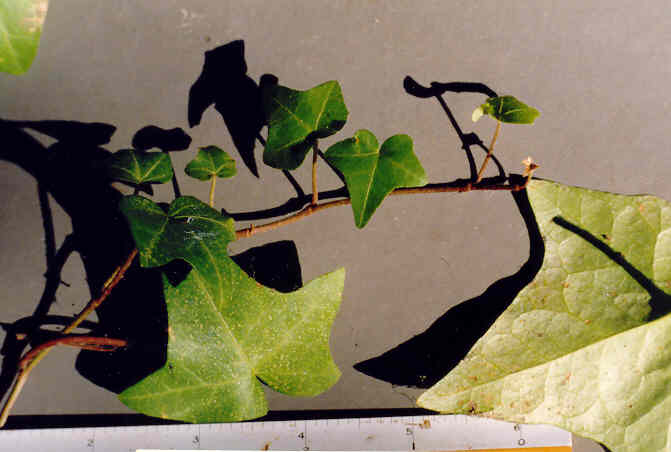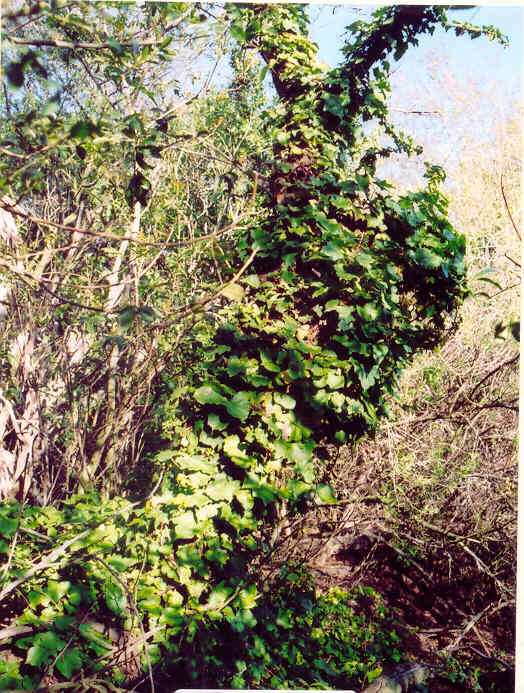
Hedera helix L.
Araliaceae (Aralia Family)
Europe
 |
Hedera helix L.Araliaceae (Aralia Family)Europe
English Ivy |
February Photo
Plant Characteristics:
Polymorphous species represented by nearly 40 recognized foliage forms;
juvenile lvs. alternate, widely various, stiffish, usually 3-5 lobed, sometimes
cleft, margins nearly or quite entire, narrowly or broadly triangular-ovate to
nearly reniform in outline, varying in size from .5-5 in. long and of similar
width, bases usually cordate to truncate, veins often light colored; lvs. on
fruiting branches usually narrowly ovate, unlobed, with truncate to cuneate
base, hairs of petiole and lower side of lf. all stellate; fls. bisexual,
greenish, in umbels assembled in terminal panicles or racemes; calyx 5-toothed;
petals 5, valvate; stamens 5; ovary 5-celled; fr. globose, usually black about
.25 in. across.
Habitat:
Ground cover or to cover walls and as a house plant.
When well rooted is drought tolerant.
Juvenile leaves produce aerial rootlets, which allow the plant to climb.
Name:
Hed-era, classical name of ivy.
Helix, Latin name for a kind of
ivy. (Bailey 746).
Greek, helix, anything twisted or wound; also a tendril, a kind of ivy.
(Jaeger 117).
General:
Uncommon in the study having been found twice as an escape from
cultivation; once under a willow and Fraxinus
canopy in upper Big Canyon and again below Eastbluff Dr. several hundred feet
easterly of its intersection with Back Bay Dr. where a storm drain enters the
bay. (my comments).
When well rooted this plant is drought tolerant.
Juvenile leaves produce aerial rootlets which allow the plant to climb.
Mature plants will eventually develop stiff branches toward top of vine
which bear round clusters of small greenish flowers followed by black berries.
These branches have unlobed leaves; rooted cuttings from such branches
will have the same kind of leaves and will be shrubby, not vining.
(Sunset Editors, New Western Garden Book 1984, 319).
A half dozen or less species of evergreen shrubs native Europe to Japan.
(Bailey 746).
The saponin content of the plant may produce severe stomach pains,
diarrhea, labored breathing, and eventually coma if the poisonous parts are
eaten in quantity. Serious cases
have proved fatal. (James 31).
Juice can cause contact dermatitis.
Berries and leaves toxic when eaten.
(Hickman, Ed. 169).
The leaves are used as a stimulant, a vulnerary, (a healing application
for wounds), an exanthema, (a treatment for rash or disease), and an
insecticide. The berries are used as an emetic and cathartic.
(Meyer 39).
Text Ref:
Bailey 746; Hickman, Ed. 169; Sunset Editors, New Western Garden Book
1984, 319.
Photo Ref:
Feb-April 91 #3,4 Oct 02-Mar 03 # 9.
Identity: by R. De Ruff.
Computer Ref: Plant Data 415.
Have plant specimen.
Last edit 10/17/02.
 |
February Photo